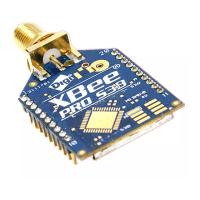Network configurations Basic communications
XBee®-PRO 900HP/XSC RF Modules
237
Acknowledged mode
Characteristics: Reliable delivery through positive acknowledgments for each packet
Throughput, latency, and jitter vary depending on the quality of the channel and the strength of the
signal.
Recommended use: Acknowledge Mode configuration is appropriate when reliable delivery is
required between modules. If messages are smaller than 256 bytes, use RB and RO commands to
align RF packets with application packets.
Required parameter values (TX device): RR (Retries) >= 1
Related commands: Networking (DT, MK, RR), Serial Interfacing (PK, RN, TT, RO, RB)
The following table shows a sample network profile.
Device Parameter settings (assume default values for parameter not listed)
All ATRR A [set the number of retries to 0x0A]
ATRN 5 [set the number of delay slots to 5]
Acknowledged mode connection sequence
After sending a packet while in Acknowledged Mode, the transmitting device listens for the ACK
(acknowledgment). If it receives the ACK, it either sends a subsequent packet (if more transmit data
is pending), or waits for exactly RN random delay slots before allowing another transmission (if no
more data is pending for transmission).
n If the transmitting device does not receive the ACK within the allotted time, it retransmits the
packet with a new RF initializer following the ACK slot. There is no delay between the first ACK
slot and the first retransmission. Subsequent retransmissions incur a delay of a random
number of delay slots, between 0 and RN.
n If RN is set to 0 on the transmitting device, there are never any back-off delays between
retransmissions. During back-off delays, the transmitting device enters Idle Mode and may
receive RF data. This can increase the back-off delay, as the radio cannot return to RF transmit
(or retransmit) mode as long as it is receiving RF data.
After receiving and acknowledging a packet, the receiving device moves to the next frequency and
listens for either a retransmission or new data for a specific period of time. Even if the transmitting
device indicates no more pending transmit data, it may have not received the previous ACK and may
retransmit the packet (potentially with no delay after the ACK slot). In this case, the receiving device
always detects the immediate retransmission, which holds off the communications channel and
reduces collisions.
Receiving devices acknowledge each retransmission they receive, but they only pass the first copy of a
packet received out the UART. RB and RO parameters are not applied to subsequent packets. This
means that once transmission has begun, it continues uninterrupted until the DI buffer is empty or
reaches its streaming limit (TT).
As with the first packet, the payload of each subsequent packet includes up to the maximum packet
size (PK parameter).
n The transmitting device checks for more pending data near the end of each packet.
n The streaming limit (TT parameter) specifies the maximum number of bytes the transmitting
device sends in one transmission event, which may consist of many packets and retries. If it
reaches the TT parameter, the transmitting device forces a random delay of 1 to RN delay slots
(exactly 1 delay slot if RN is zero).

